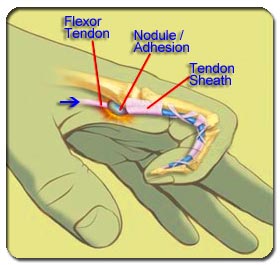
Causes of Trigger Finger SyndromeThere are a variety of reasons that Trigger Finger occurs, but the most prominent two causes of this devastating disorder are Repetitive Strain Injury and Direct Trauma. Repetitive Strain Injury:
Repetitive overuse of the fingers in activities that result in the "excessive" use of the fingers in any activities that require finger flexion. This can range from typing to driving. The development of Trigger Finger via a repetitive stress does not necessarily have to involve movement; as those individuals that are grasping power tools are still overusing the finger flexor tendons / muscles in a repetitive nature (repeated static, non-moving flexion) although they are not even moving their fingers. It is the "excessive stress" and strain that the finger flexors endure that cause the disorder to appear. If the finger flexor muscles / tendons are not stronger than the activities to which they are subjected, they are bound to become injured with micro-tears developing in the flexor tendon(s). As the micro-tears develop, they attempt to heal themselves via scarring. The scar tissue begins to accumulate which then makes the tendon larger than it should be, resulting in increased friction of the nodule on the tendon against the tendon sheath. The in turn causes irritation, swelling and the sheath no longer allows the nodule to pass through with ease, causing a "locking" of the finger in the flexed-forward position into the palm of the hand, and resulting in the painful symptoms of Trigger Finger syndrome. Direct Trauma:Trigger Finger is often the result of direct injury to the tendon via micro-tears resulting from blunt trauma that cause immediate micro-tears in the flexor tendon(s). Once these micro-tears occur, the body attempts to heal itself, resulting in the formation of scar tissue / fibrotic adhesion(s) on the tendon itself. AS the adhesion develops, it becomes larger than the affected tendon and therefore larger than what the tendon sheath can handle, resulting in excessive friction of the nodule against the tendon sheath, resulting in increased friction, swelling, and finally, the inability of the tendon nodule to pass back through the tendon sheath when the finger is in the flexed position. Thus the finger becomes "locked" into the palm of the hand, causing severe discomfort when the finger is either manually moved or naturally "snaps" back into the extended position. Either way, both of these "causes" of Trigger finger can be treated effectively WITHOUT invasive methods! Trigger finger also develops due to more serious conditions that you will need to discuss with your primary-care physician:Rheumatoid Arthritis, repeated trauma from pistol gripped power tools, partial tendon lacerations or long hours grasping a steering wheel can result in the development of Trigger Finger Syndrome. Trigger Finger may also be caused by an infection of the synovium, causing the scarring and formation of an adhesion / nodule on the flexor tendon. Trigger Finger can also be caused by a congenital defect that forms an adhesion / nodule inside of the tendon. The condition is not usually noticeable until the infant begins to use its hands. |
BSI Hours: |

Copyright© - www.TriggerFingerCause.com - All Rights Reserved |
